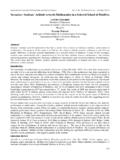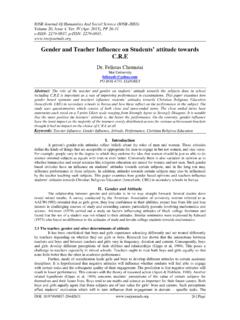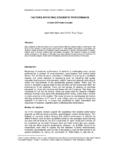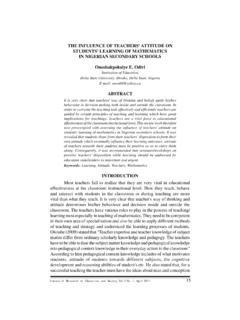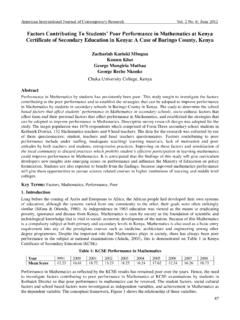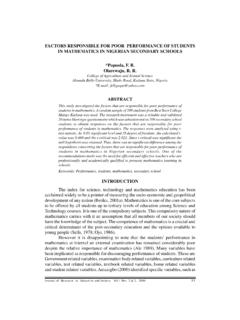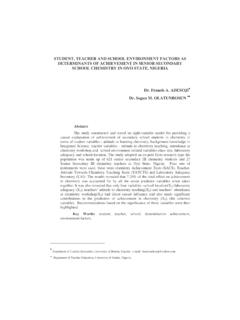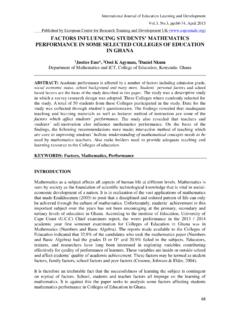Transcription of HIGH SCHOOL STUDENTS’ ATTITUDE TOWARDS …
1 International Journal of Scientific and Research Publications, Volume 3, Issue 9, September 2013 1 ISSN 2250-3153 high SCHOOL students ATTITUDE TOWARDS Learning English Language Gajalakshmi Abstract: A study was attempted to investigate the IX-standard students ATTITUDE TOWARDS learning English language. A standardized questionnaire was administered in the form of normative survey to 600 IX standard students (selected randomly from various high and higher secondary schools in Puducherry region) to collect their ATTITUDE TOWARDS learning English language. The collected data was statistically analyzed by SPSS ver-16. The results revealed that there is a significant difference based on the gender, locality of the SCHOOL , type of SCHOOL , type of management.
2 Hence it was concluded that more classroom activities in the study of English enhance pupils ATTITUDE to learn English. I. INTRODUCTION Education is the powerful tool which helps to modify the behavior of the child according to the needs and expectancy of the society. Student s ATTITUDE is an integral part of learning and that it should, therefore become an essential component of second language learning pedagogy. attitudes toward learning are believed to influence behaviors such as selecting and reading books, speaking in a foreign language etc. Especially in Education, if the students have positive ATTITUDE TOWARDS any subject, they can achieve many things in that specific area. There is an interaction between language learning and the environmental components in which the students were grown up.
3 Both negative and positive attitudes have a strong impact on the success of language learning. ATTITUDE is determined by the individual s beliefs about outcomes or attributes of performing the behavior (behavioral beliefs), weighted by evaluations of those outcomes or attributes. Thus, a person who holds strong beliefs that positively valued outcomes will result from performing the behavior will have a positive ATTITUDE toward the behavior. Conversely, a person who holds strong beliefs that negatively valued outcomes will result from the behavior will have a negative ATTITUDE . ATTITUDE concept can be viewed from these three dimensions. Each one of these dimensions has different features to bring out language ATTITUDE results. Accordingly, the ATTITUDE concept has three components , behavioral, cognitive and affective.
4 These three attitudinal aspects are based on the three theoretical approaches of behaviorism, cognitivism and humanism respectively. II. BEHAVIORAL ASPECT OF ATTITUDE The behavioral aspect of ATTITUDE deals with the way one behaves and reacts in particular situations. In fact, the successful language learning enhances the learners to identify themselves with the native International Journal of Scientific and Research Publications, Volume 3, Issue 9, September 2013 2 ISSN 2250-3153 speakers of that language and acquire or adopt various aspects of behaviors which characterize the members of the target language community. Cognitive Aspect of ATTITUDE This aspect of ATTITUDE involves the beliefs of the language learners about the knowledge that they receive and their understanding in the process of language learning.
5 The cognitive ATTITUDE can be classified into four steps of connecting the previous knowledge and the new one, creating new knowledge, checking new knowledge, and applying the new knowledge in many situations Emotional Aspect of ATTITUDE Feng .R and Chen .H (2009) stated that, Learning process is an emotional process. It is affected by different emotional factors. The teacher and his students engage in various emotional activities in it and varied fruits of emotions are yield. ATTITUDE can help the learners to express whether they like or dislike the objects or surrounding situations. It is agreed that the inner feelings and emotions of learners influence their perspectives and their attitudes TOWARDS the target language (Choy & Troudi.)
6 S, 2006). III. NEED FOR THE STUDY Though the 10+2+3 pattern of education had introduced in Tamilnadu as early as 1978, not many empirical studies have been conducted on the various aspects of this newly introduced pattern of education. It is well known that this pattern of education was introduced in a hurry without caring for even the most essential of the hour. Hence the investigator has made an attempt in this study. It has become imperative to study the level of students ATTITUDE TOWARDS English as it has become a main subject of competency. As a subject it has become a pivotal in the education system. It is also important to study the methods and approaches in learning English. The level of 9th standard SCHOOL students standard in English and study their ATTITUDE become the need of the hour.
7 Hence the investigator has made an attempt in this study. high SCHOOL period is an important stage to the students to face lot of competition and it is a gate way for them to enter into the higher studies. So they are aware of the importance of English, how it is mainly helpful to them to do well in the academic study and their professional life in future. Since they want to continue their higher studies in Puducherry, the English is considered as the second language in every SCHOOL . It is tough for the students to understand the English language. Hence the investigator feels that the class room activities in the study of English should develop the pupils ATTITUDE TOWARDS the study of English and it should help them to enhance interest to learn English. IV.
8 OBJECTIVES OF THE STUDY 1. To find out the 9th standard SCHOOL students ATTITUDE TOWARDS English. 2. To find out the ATTITUDE of 9th standard SCHOOL students TOWARDS English in relation to the following variables. Gender International Journal of Scientific and Research Publications, Volume 3, Issue 9, September 2013 3 ISSN 2250-3153 Medium of Instruction Religion Locality of the SCHOOL Type of SCHOOL Type of management V. HYPOTHESES OF THE STUDY 1. The ATTITUDE of the 9th standard students in English is high . 2. There is no significant difference in the ATTITUDE of 9th standard students in learning English with respect to the following variables a. Gender (male/female) b. Medium of Instruction (Tamil and English medium) d.
9 Religion (Hindu/Christian/Muslim) e. Locality of the SCHOOL .(Rural/Urban) f. Type of SCHOOL (Boys/Girls/Co-Educational) g. Type of management.(Government/Private) VI. TOOL USED Likert type of ATTITUDE scale designed with the help of the standardized tool prepared by Dr. Lilly Epsy Bhai and S. Magethiran was used for this normative survey. The five point scale consists of 28 test items with 14 favorable and 14 unfavorable statements against five different responses viz "strongly agree" (SA) "Agree" (A) Undecided (UD), Disagree (DA) and "Strongly Disagree" (SD). VII. SCORING PROCEDURE A score of '4', '3', '2', '1', and '0' are given to the responses of the sample in the given order for the favorable statements and they are reversed for the unfavorable statements.
10 The grant score was used to interpret the overall ATTITUDE of the individual. RELIABILITY AND VALIDITY To measure the reliability of the tool, the researcher has adopted retest method. The same ATTITUDE scale is administered to different occasions for the same population with a month interval. The t value for the scale was found to be significant at level. To measure the validity of the tool the researcher has International Journal of Scientific and Research Publications, Volume 3, Issue 9, September 2013 4 ISSN 2250-3153 received opinions and judgment from experts and authorities. In this way the validity of the tool is measured. SAMPLE OF THE STUDY Random Sampling method was used to select the samples.










